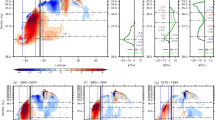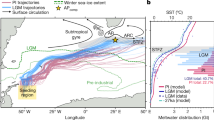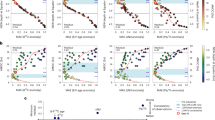Abstract
Extreme, abrupt Northern Hemisphere climate oscillations during the last glacial cycle (140,000 years ago to present) were modulated by changes in ocean circulation and atmospheric forcing1. However, the variability of the Atlantic meridional overturning circulation (AMOC), which has a role in controlling heat transport from low to high latitudes and in ocean CO2 storage, is still poorly constrained beyond the Last Glacial Maximum2,3,4. Here we show that a deep and vigorous overturning circulation mode has persisted for most of the last glacial cycle, dominating ocean circulation in the Atlantic, whereas a shallower glacial mode with southern-sourced waters filling the deep western North Atlantic prevailed during glacial maxima3,5. Our results are based on a reconstruction of both the strength and the direction of the AMOC during the last glacial cycle from a highly resolved marine sedimentary record in the deep western North Atlantic. Parallel measurements of two independent chemical water tracers (the isotope ratios of 231Pa/230Th and 143Nd/144Nd)6,7,8, which are not directly affected by changes in the global cycle, reveal consistent responses of the AMOC during the last two glacial terminations. Any significant deviations from this configuration, resulting in slowdowns of the AMOC, were restricted to centennial-scale excursions during catastrophic iceberg discharges of the Heinrich stadials. Severe and multicentennial weakening of North Atlantic Deep Water formation occurred only during Heinrich stadials close to glacial maxima with increased ice coverage, probably as a result of increased fresh-water input. In contrast, the AMOC was relatively insensitive to submillennial meltwater pulses during warmer climate states, and an active AMOC prevailed during Dansgaard–Oeschger interstadials (Greenland warm periods).
This is a preview of subscription content, access via your institution
Access options
Subscribe to this journal
Receive 51 print issues and online access
$199.00 per year
only $3.90 per issue
Buy this article
- Purchase on Springer Link
- Instant access to full article PDF
Prices may be subject to local taxes which are calculated during checkout




Similar content being viewed by others
References
Rahmstorf, S. Ocean circulation and climate during the past 120,000 years. Nature 419, 207–214 (2002)
Adkins, J. The role of deep ocean circulation in setting glacial climates. Paleoceanography 28, 539–561 (2013)
Boyle, E. & Keigwin, L. North Atlantic thermohaline circulation during the past 20,000 years linked to high-latitude surface temperature. Nature 330, 35–40 (1987)
Sigman, D., Hain, M. & Haug, G. The polar ocean and glacial cycles in atmospheric CO2 concentration. Nature 466, 47–55 (2010)
Sarnthein, M. et al. Changes in east Atlantic deepwater circulation over the last 30,000 years: eight time slice reconstructions. Paleoceanography 9, 209–267 (1994)
Yu, E., Francois, R. & Bacon, M. Similar rates of modern and last-glacial ocean thermohaline circulation inferred from radiochemical data. Nature 379, 689–694 (1996)
Piotrowski, A., Goldstein, S., Hemming, S. & Fairbanks, R. Temporal relationships of carbon cycling and ocean circulation at glacial boundaries. Science 307, 1933–1938 (2005)
Roberts, N., Piotrowski, A., McManus, J. & Keigwin, L. Synchronous deglacial overturning and water mass source changes. Science 327, 75–78 (2010)
Lynch-Stieglitz, J. et al. Atlantic meridional overturning circulation during the Last Glacial Maximum. Science 316, 66–69 (2007)
Keigwin, L. & Jones, G. Western North Atlantic evidence for millennial-scale changes in ocean circulation and climate. J. Geophys. Res. 99, 12397–12410 (1994)
Adkins, J., Boyle, E., Keigwin, L. & Cortijo, E. Variability of the North Atlantic thermohaline circulation during the last interglacial period. Nature 390, 154–156 (1997)
Frank, M. Radiogenic isotopes: tracers of past Ocean Circulation and erosional input. Rev. Geophys. 40, 1001 (2002)
McManus, J., Francois, R., Gherardi, J., Keigwin, L. & Brown-Leger, S. Collapse and rapid resumption of Atlantic meridional circulation linked to deglacial climate change. Nature 428, 834–837 (2004)
Sachs, J. & Lehman, S. Subtropical North Atlantic temperatures 60,000 to 30,000 years ago. Science 286, 756–759 (1999)
Tzedakis, P. et al. Can we predict the duration of an interglacial? Clim. Past 8, 1473–1485 (2012)
Carlson, A. Why there was not a Younger Dryas-like event during the penultimate deglaciation. Quat. Sci. Rev. 27, 882–887 (2008)
Piepgras, D. & Wasserburg, G. Rare earth element transport in the western North Atlantic inferred from Nd isotopic observations. Geochim. Cosmochim. Acta 51, 1257–1271 (1987)
McManus, J., Oppo, D. & Cullen, J. A 0.5-million-year record of millennial-scale climate variability in the North Atlantic. Science 283, 971–975 (1999)
Carlson, A. & Clark, P. Ice sheet sources of sea level rise and freshwater discharge during the last deglaciation. Rev. Geophys. 50, RG4007 (2012)
Thornalley, D., Barker, S., Becker, J., Hall, I. & Knorr, G. Abrupt changes in deep Atlantic circulation during the transition to full glacial conditions. Paleoceanography 28, 253–262 (2013)
Rasmussen, T., Oppo, D., Thomsen, E. & Lehman, S. Deep sea records from the southeast Labrador Sea: ocean circulation changes and ice-rafting events during the last 160,000 years. Paleoceanography 18, 1081 (2003)
Keigwin, D. & Boyle, E. Did North Atlantic overturning halt 17,000 years ago? Paleoceanography 23, PA1101 (2008)
Lippold, J. et al. Does sedimentary 231Pa/230Th from the Bermuda Rise monitor past Atlantic meridional overturning circulation? Geophys. Res. Lett. 36, L12601 (2009)
Lacan, F. & Jeandel, C. Acquisition of the neodymium isotopic composition of the North Atlantic Deep Water. Geochem. Geophys. Geosyst. 6, Q12008 (2005)
Hillaire-Marcel, C., de Vernal, A., Bilodeau, G. & Weaver, A. Absence of deep-water formation in the Labrador Sea during the last interglacial period. Nature 410, 1073–1077 (2001)
Jaccard, S. et al. Two modes of change in Southern Ocean productivity over the past million years. Science 339, 1419–1423 (2013)
Gutjahr, M. & Lippold, J. Early arrival of Southern Source Water in the deep North Atlantic prior to Heinrich event 2. Paleoceanography 26, PA2101 (2011)
Berger, A. & Loutre, M. Insolation values for the climate of the last 10 million years. Quat. Sci. Rev. 10, 297–317 (1991)
Andersen, K. et al. The Greenland ice core chronology 2005, 15–42 ka. Part 1: constructing the time scale. Quat. Sci. Rev. 25, 3246–3257 (2006)
Waelbroeck, C. et al. Sea-level and deep water temperature changes derived from benthic foraminifera isotopic records. Quat. Sci. Rev. 21, 295–305 (2002)
Gutjahr, M. et al. Reliable extraction of a deepwater trace metal isotope signal from Fe–Mn oxyhydroxide coatings of marine sediments. Chem. Geol. 242, 351–370 (2007)
Cohen, A., Onions, R., Siegenthaler, R. & Griffin, W. Chronology of the pressure-temperature history recorded by a granulite terrain. Contrib. Mineral. Petrol. 98, 303–311 (1988)
Pin, C., Briot, D., Bassin, C. & Poitrasson, F. Concomitant separation of strontium and samarium-neodymium for isotopic analysis in silicate samples, based on specific extraction chromatography. Anal. Chim. Acta 298, 209–217 (1994)
Gutjahr, M., Frank, M., Stirling, C., Keigwin, L. & Halliday, A. Tracing the Nd isotope evolution of North Atlantic Deep and Intermediate Waters in the western North Atlantic since the LGM from Blake Ridge sediments. Earth Planet. Sci. Lett. 266, 61–77 (2008)
Pahnke, K., Goldstein, S. & Hemming, S. Abrupt changes in Antarctic Intermediate Water circulation over the past 25,000 years. Nature Geosci. 1, 870–874 (2008)
Wilson, D., Piotrowski, A., Galy, A. & Clegg, J. Reactivity of neodymium carriers in deep sea sediments: implications for boundary exchange and paleoceanography. Geochim. Cosmochim. Acta 109, 197–221 (2013)
Elmore, A., Piotrowski, A., Wright, J. & Scrivner, A. Testing the extraction of past seawater Nd isotopic composition from North Atlantic deep sea sediments and foraminifera. Geochem. Geophys. Geosyst. 12, Q09008 (2011)
Piotrowski, A. et al. Reconstructing deglacial North and South Atlantic deep water sourcing using foraminiferal Nd isotopes. Earth Planet. Sci. Lett. 357–358, 289–297 (2012)
Roberts, N., Piotrowski, A., Elderfield, H., Eglinton, T. & Lomas, M. Rare earth element association with foraminifera. Geochim. Cosmochim. Acta 94, 57–71 (2012)
Vance, D. & Thirlwall, M. An assessment of mass discrimination in MC-ICPMS using Nd isotopes. Chem. Geol. 185, 227–240 (2002)
Tanaka, T. et al. JNdi-1: a neodymium isotopic reference in consistency with La Jolla neodymium. Chem. Geol. 168, 279–281 (2000)
Pichat, S. et al. Lower export production during glacial periods in the equatorial Pacific derived from 231Pa/230Thxs,0 measurements in deep-sea sediments. Paleoceanography 19, PA4023 (2004)
Geibert, W. & Vöge, I. Progress in determination of 227-Ac in sea water. Mar. Chem. 109, 238–249 (2008)
Hansen, R. & Ring, E. The Preparation and Certification of a Uranium Reference Material Vol. M84 (Randburg, 1983)
Fietzke, J., Bollhöfer, A., Frank, N. & Mangini, A. Pa determination in manganese crust VA12/2 by TIMS. Nucl. Instrum. Methods Phys. Res. B 149, 353–360 (1999)
Christl, M., Lippold, J., Steinhilber, F., Bernsdorff, F. & Mangini, A. Reconstruction of global 10Be production over the past 250 ka from highly accumulating Atlantic drift sediments. Quat. Sci. Rev. 29, 2663–2672 (2010)
Henderson, G. & Anderson, R. The U-series toolbox for paleoceanography. Rev. Mineral. Geochem. 52, 493–531 (2003)
Müller, R. & Schneider, R. An automated leaching method for the determination of opal in sediments and particulate matter. Deep-Sea Res. I 40, 425–444 (1993)
Wolff, E., Chappellaz, J., Blunier, T., Rasmussen, S. & Svensson, A. Millennial-scale variability during the last glacial: the ice core record. Quat. Sci. Rev. 29, 2828–2838 (2010)
Svensson, A. et al. The Greenland ice core chronology 2005, 15–42 ka. Part 2: comparison to other records. Quat. Sci. Rev. 25, 3258–3267 (2006)
Jaeschke, A., Rühlemann, C., Arz, H., Heil, G. & Lohmann, G. Coupling of millennial-scale changes in sea surface temperature and precipitation off northeastern Brazil with high-latitude climate shifts during the last glacial period. Paleoceanography 22, PA4206 (2007)
Channell, J., Hodell, D. & Curtis, J. ODP Site 1063 (Bermuda Rise) revisited: oxygen isotopes, excursions and paleointensity in the Brunhes Chron. Geochem. Geophys. Geosyst. 13, Q02001 (2012)
Anderson, B., Bacon, M. & Brewer, P. Removal of 230Th and 231Pa at ocean margins. Earth Planet. Sci. Lett. 66, 73–90 (1983)
Gil, I., Keigwin, L. & Abrantes, F. Deglacial diatom productivity and surface ocean properties over the Bermuda Rise, northeast Sargasso Sea. Paleoceanography 24, PA4101 (2009)
Lippold, J. et al. Strength and geometry of the glacial Atlantic meridional overturning circulation. Nature Geosci. 5, 813–816 (2012)
Lacan, F. & Jeandel, C. Subpolar Mode Water formation traced by neodymium isotopic composition. Geophys. Res. Lett. 31, L14306 (2004)
Piepgras, D. & Wasserburg, G. Neodymium isotopic variations in seawater. Earth Planet. Sci. Lett. 50, 128–138 (1980)
Stordal, M. & Wasserburg, G. Neodymium isotopic study of Baffin Bay water: sources of REE from very old terranes. Earth Planet. Sci. Lett. 77, 259–272 (1986)
Foster, G., Vance, D. & Prytulak, J. No change in the neodymium isotope composition of deep water exported from the North Atlantic on glacial-interglacial time scales. Geology 35, 37–40 (2007)
van de Flierdt, T., Robinson, L., Adkins, J., Hemming, S. & Goldstein, S. Temporal stability of the neodymium isotope signature of the Holocene to glacial North Atlantic. Paleoceanography 21, PA4102 (2006)
Swift, J. The circulation of the Denmark Strait and Iceland-Scotland overflow waters in the North Atlantic. Deep-Sea Res. A 31, 1339–1355 (1984)
Lacan, F. & Jeandel, C. Neodymium isotopic composition and rare earth element concentrations in the deep and intermediate Nordic Seas: constraints on the Iceland Scotland Overflow Water signature. Geochem. Geophys. Geosyst. 5, Q11006 (2004)
Stichel, T., Frank, M., Rickli, J. & Haley, B. The hafnium and neodymium isotope composition of seawater in the Atlantic sector of the Southern Ocean. Earth Planet. Sci. Lett. 317–318, 282–294 (2012)
Guihou, A. et al. Enhanced Atlantic meridional overturning circulation supports the last glacial inception. Quat. Sci. Rev. 30, 1576–1582 (2011)
Bronk Ramsey, C. & Lee, S. Recent and planned developments of the program OxCal. Radiocarbon 55, 720–730 (2013)
Reimer, P. J. et al. IntCal13 and Marine13 radiocarbon age calibration curves 0-50,000 years cal BP. Radiocarbon 55, 1869–1887 (2013)
Acknowledgements
Sediment material for this study was provided by the ODP/IODP core repository Bremen. The manuscript benefited from input by S. Jaccard and A. Mangini. We thank J. Grützner, H. Dicht, J. Link and S. Rheinberger for advice and analytical assistance. Financial support for this research was provided by the Deutsche Forschungsgemeinschaft through grant Ma821/41 to E.B. J.L. was supported by the FP7-PEOPLE-2013-IEF, Marie Curie proposal 622483.
Author information
Authors and Affiliations
Contributions
J.L. developed the concept and designed the study. E.B., J.L., P.B. and B.A. carried out the chemical preparations of the samples. E.B., J.L., M.B.A. and B.A. performed opal, U, Th and Pa measurements. E.B., J.L., M.G. and P.B. performed the Nd isotope measurements. J.F. improved the age model. J.L., E.B., M.G., M.F., M.B.A., J.F., N.F. and M.D. interpreted the results and wrote the manuscript.
Corresponding author
Ethics declarations
Competing interests
The authors declare no competing financial interests.
Extended data figures and tables
Extended Data Figure 1 Bermuda Rise sediment Ti/Ca compared with NGRIP ice-core δ18O.
Age control points (red) aligning the Ti/Ca profile of ODP 1063 (b) with the δ18O time series of the NGRIP ice core (a).
Extended Data Figure 3 Comparison of age models for ODP 1063.
Tuning points used in this study and by ref. 20. The age models agree within few 100 yr.
Extended Data Figure 4 231Pa/230Th and opal concentration records of ODP 1063.
Comparison of the 231Pa/230Th data (a; error bars, 2 s.d.) with the variations in the opal concentration (b; error bars, 2 s.d.).
Extended Data Figure 5 231Pa/230Th as a function of opal concentration.
According to the P value the weak positive correlation (r2 = 0.16, α > 5%) of the opal concentration (error bars, 2 s.d.) and the 231Pa/230Th ratio (error bars, 2 s.d.) is not significant. The grey shaded area indicates preserved opal concentrations above 5%, below which no measurable influence on sedimentary 231Pa/230Th has been found in the framework of an Atlantic-wide study55.
Extended Data Figure 6 Three-box model including Nd isotope ratios, Nd concentrations and exchange rates.
 ij is the water exchange between the boxes i and j, εi is the Nd isotope composition, and ci is the Nd concentration.
ij is the water exchange between the boxes i and j, εi is the Nd isotope composition, and ci is the Nd concentration.
Extended Data Figure 7 Fraction of NADW at the Bermuda Rise.
Water mass mixing is derived from a linear mixing model and εNd data sets from ODP 1063 and RC11-83/TN0577 for three different εNd(NADW) values. Given the uncertainties of the boundary conditions, in particular Nd concentrations and endmember variability, we focus on the long-term trend of the AMOC only and use a 10 kyr running mean for εNd(ODP 1063) and εNd(SSW). For the calculations a range of endmember compositions for εNd(NADW) has been assumed (−14 to −16), defining the range of uncertainty (bright blue). The calculations show that there was an increase in the fraction of SSW and a decrease in the fraction of NSW in the water mass mixture at ODP 1063 only during the peak of the last glacial period.
Extended Data Figure 9 North Atlantic 231Pa/230Th profiles.
Data from ODP 1063 (red; error bars, 2 s.d.) compared with data from SU90-1164 (black; error bars, 1 s.d.).
Supplementary information
Supplementary Data
This file contains Supplementary Table 1. (XLS 104 kb)
Rights and permissions
About this article
Cite this article
Böhm, E., Lippold, J., Gutjahr, M. et al. Strong and deep Atlantic meridional overturning circulation during the last glacial cycle. Nature 517, 73–76 (2015). https://doi.org/10.1038/nature14059
Received:
Accepted:
Published:
Issue Date:
DOI: https://doi.org/10.1038/nature14059
This article is cited by
-
Southern Ocean glacial conditions and their influence on deglacial events
Nature Reviews Earth & Environment (2023)
-
Enhanced subglacial discharge from Antarctica during meltwater pulse 1A
Nature Communications (2023)
-
Millennial atmospheric CO2 changes linked to ocean ventilation modes over past 150,000 years
Nature Geoscience (2023)
-
Bipolar impact and phasing of Heinrich-type climate variability
Nature (2023)
-
Evolution characteristics of the Atlantic Meridional Overturning Circulation and its thermodynamic and dynamic effects on surface air temperature in the Northern Hemisphere
Science China Earth Sciences (2023)
Comments
By submitting a comment you agree to abide by our Terms and Community Guidelines. If you find something abusive or that does not comply with our terms or guidelines please flag it as inappropriate.



